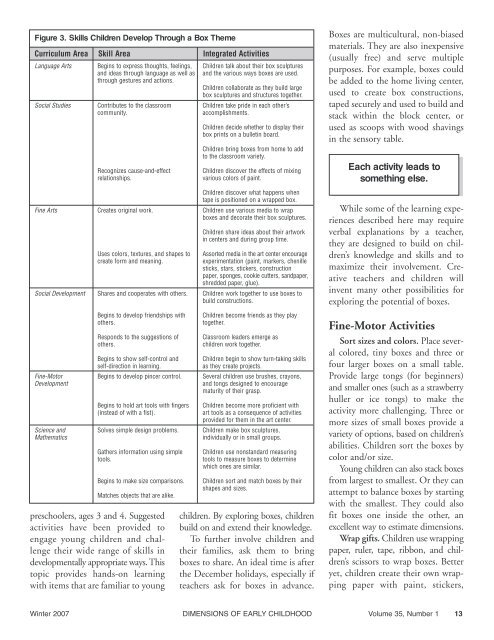Dimensions of Early Childhood - Southern Early Childhood ...
Dimensions of Early Childhood - Southern Early Childhood ...
Dimensions of Early Childhood - Southern Early Childhood ...
You also want an ePaper? Increase the reach of your titles
YUMPU automatically turns print PDFs into web optimized ePapers that Google loves.
Figure 3. Skills Children Develop Through a Box Theme<br />
Curriculum Area Skill Area Integrated Activities<br />
Language Arts<br />
Social Studies<br />
Begins to express thoughts, feelings,<br />
and ideas through language as well as<br />
through gestures and actions.<br />
Contributes to the classroom<br />
community.<br />
Recognizes cause-and-effect<br />
relationships.<br />
Children talk about their box sculptures<br />
and the various ways boxes are used.<br />
Children collaborate as they build large<br />
box sculptures and structures together.<br />
Children take pride in each other’s<br />
accomplishments.<br />
Children decide whether to display their<br />
box prints on a bulletin board.<br />
Children bring boxes from home to add<br />
to the classroom variety.<br />
Children discover the effects <strong>of</strong> mixing<br />
various colors <strong>of</strong> paint.<br />
Boxes are multicultural, non-biased<br />
materials. They are also inexpensive<br />
(usually free) and serve multiple<br />
purposes. For example, boxes could<br />
be added to the home living center,<br />
used to create box constructions,<br />
taped securely and used to build and<br />
stack within the block center, or<br />
used as scoops with wood shavings<br />
in the sensory table.<br />
Each activity leads to<br />
something else.<br />
Fine Arts<br />
Social Development<br />
Creates original work.<br />
Uses colors, textures, and shapes to<br />
create form and meaning.<br />
Shares and cooperates with others.<br />
Children discover what happens when<br />
tape is positioned on a wrapped box.<br />
Children use various media to wrap<br />
boxes and decorate their box sculptures.<br />
Children share ideas about their artwork<br />
in centers and during group time.<br />
Assorted media in the art center encourage<br />
experimentation (paint, markers, chenille<br />
sticks, stars, stickers, construction<br />
paper, sponges, cookie cutters, sandpaper,<br />
shredded paper, glue).<br />
Children work together to use boxes to<br />
build constructions.<br />
While some <strong>of</strong> the learning experiences<br />
described here may require<br />
verbal explanations by a teacher,<br />
they are designed to build on children’s<br />
knowledge and skills and to<br />
maximize their involvement. Creative<br />
teachers and children will<br />
invent many other possibilities for<br />
exploring the potential <strong>of</strong> boxes.<br />
Fine-Motor<br />
Development<br />
Science and<br />
Mathematics<br />
Begins to develop friendships with<br />
others.<br />
Responds to the suggestions <strong>of</strong><br />
others.<br />
Begins to show self-control and<br />
self-direction in learning.<br />
Begins to develop pincer control.<br />
Begins to hold art tools with fingers<br />
(instead <strong>of</strong> with a fist).<br />
Solves simple design problems.<br />
Gathers information using simple<br />
tools.<br />
Begins to make size comparisons.<br />
Matches objects that are alike.<br />
preschoolers, ages 3 and 4. Suggested<br />
activities have been provided to<br />
engage young children and challenge<br />
their wide range <strong>of</strong> skills in<br />
developmentally appropriate ways. This<br />
topic provides hands-on learning<br />
with items that are familiar to young<br />
Children become friends as they play<br />
together.<br />
Classroom leaders emerge as<br />
children work together.<br />
Children begin to show turn-taking skills<br />
as they create projects.<br />
Several children use brushes, crayons,<br />
and tongs designed to encourage<br />
maturity <strong>of</strong> their grasp.<br />
Children become more pr<strong>of</strong>icient with<br />
art tools as a consequence <strong>of</strong> activities<br />
provided for them in the art center.<br />
Children make box sculptures,<br />
individually or in small groups.<br />
Children use nonstandard measuring<br />
tools to measure boxes to determine<br />
which ones are similar.<br />
Children sort and match boxes by their<br />
shapes and sizes.<br />
children. By exploring boxes, children<br />
build on and extend their knowledge.<br />
To further involve children and<br />
their families, ask them to bring<br />
boxes to share. An ideal time is after<br />
the December holidays, especially if<br />
teachers ask for boxes in advance.<br />
Fine-Motor Activities<br />
Sort sizes and colors. Place several<br />
colored, tiny boxes and three or<br />
four larger boxes on a small table.<br />
Provide large tongs (for beginners)<br />
and smaller ones (such as a strawberry<br />
huller or ice tongs) to make the<br />
activity more challenging. Three or<br />
more sizes <strong>of</strong> small boxes provide a<br />
variety <strong>of</strong> options, based on children’s<br />
abilities. Children sort the boxes by<br />
color and/or size.<br />
Young children can also stack boxes<br />
from largest to smallest. Or they can<br />
attempt to balance boxes by starting<br />
with the smallest. They could also<br />
fit boxes one inside the other, an<br />
excellent way to estimate dimensions.<br />
Wrap gifts. Children use wrapping<br />
paper, ruler, tape, ribbon, and children’s<br />
scissors to wrap boxes. Better<br />
yet, children create their own wrapping<br />
paper with paint, stickers,<br />
Winter 2007 DIMENSIONS OF EARLY CHILDHOOD Volume 35, Number 1 13

















